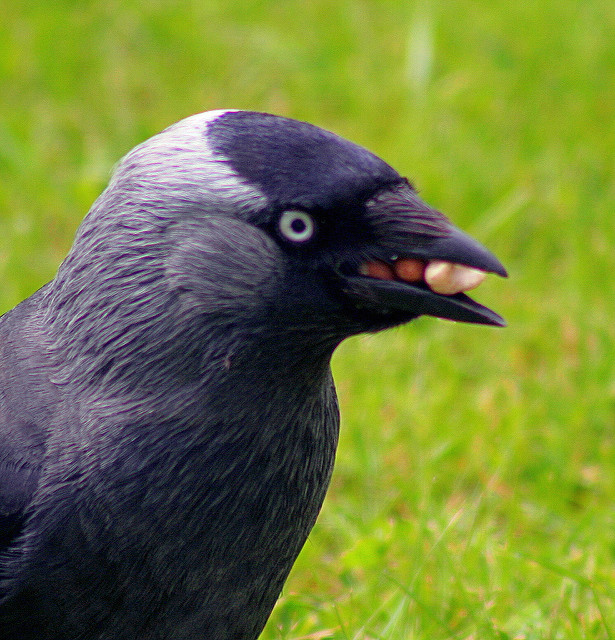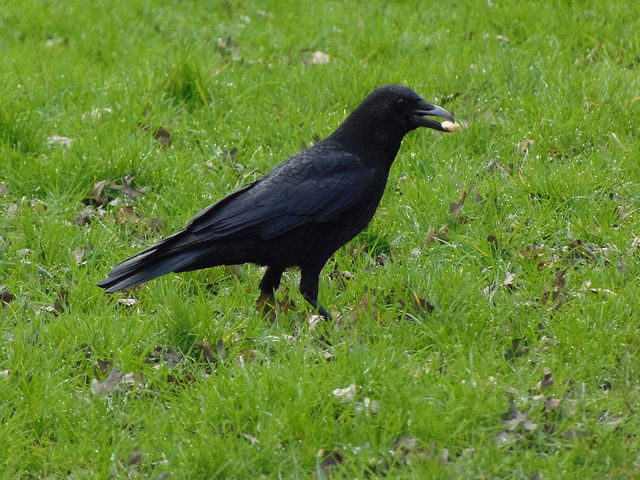I knew birds had to be doing this from the simple observation that the trees are widely distributed always. Other animals actually stick pretty close to paths and have little opportunity to properly distribute seeds.
Now we know which ones. More to the point is that we need to protect narrow wild tree bands perhaps no more than a mile apart to encourage this activity. this allows rapid refurbishment of woodlands.
We have always organized our fields to suit ourselves with spotty results. integrating our forests into the mix has long been beneficial..
.
Corvids could save forests from the effects of climate change
Crows, jays, and nutcrackers have co-evolved with trees for good reason.
Annalee Newitz - 2/8/2016, 6:00 AM
A raven with a large seed, about to bury it in a field.
https://arstechnica.com/science/2016/02/corvids-could-save-forests-from-the-effects-of-climate-change/
To you, crows and jays might be noisy, obnoxious birds who eat garbage. But for large-seeded trees like pines, hickories, oaks, and chestnuts, they could be life-saving heroes. That's because these birds can actually relocate forests that are threatened by changing climates and habitat loss.
In a new paper published in ornithology journal The Condor, a group of US scientists describe how corvids' unique food-gathering strategies have transformed forests around the world. Now, environmental scientists are actively using the animals as part of their reforestation strategies.
Scatter-hoarding
Corvids, a family of birds that includes crows, ravens, jays, magpies, and nutcrackers, are called scatter-hoarders. They roam large territories to scavenge seeds, fruit, and even meat, storing as many morsels as possible to eat later. That's the "hoard" part. But they don't have one giant stash full of loot the way squirrels do. Instead, they hide each treat in a separate place, occasionally moving it around to prevent other animals from finding it. That's the "scatter" part. Corvids are incredibly intelligent, with excellent visual memory, and scrub jays can remember up to 200 different cache locations at any given time.

Just look how many seeds this jackdaw has jammed into its beak. Pretty impressive.
John Haslam / Flickr Unfortunately for the birds—but fortunately for forests—they can't remember everything. Each year, a certain percentage of the birds' cached seeds goes uneaten. Because the birds like to hide food just an inch or two under the soil, these seeds have a chance to take root and grow into trees.
Over millennia of evolution, this arrangement has become mutually beneficial. Many large-seeded trees have co-evolved with corvids, developing seeds that contain lots of carbohydrates so the birds fill up faster. As a result, corvids are less likely to gobble up seeds on the spot—they'll be sated and may even fly tens of kilometers to hide the seeds.
Forest builders
Corvid appetites have even helped to improve the fitness of pine and oak forests. The birds carefully select their seeds, often examining them visually and shaking them in their shells to determine whether they've been infested by fungus or arthropods. Though the birds are thinking only of what will be tastiest for them, the result is that the seeds that get scatter-hoarded tend to be the healthiest ones. Combine the corvids' pickiness with their predilection for flying great distances to hide their food, and you wind up with new patches of forest, planted by corvids, whose trees are both healthy and genetically diverse. Even better, many corvids prefer to cache their seeds in recently burned or disturbed landscapes, which are the most in need of reforestation.
Further Reading
New videos prove crows can make complex tools that only humans have made before In Poland, for example, the researchers report that old agricultural fields were reforested with black walnuts over a short fifty-year time span. This boon was entirely because local rooks and crows preferred to plant their larders in the disturbed ground of fallow farmland. A similar kind of restoration happened on two islands in California’s Channel Islands National Park. For 150 years on those islands, oak and pine forests had been ravaged by imported, non-native livestock. But when the animals were taken back to the mainland in the 1980s, the local island jays managed to double the size of the oak and pine forests in just a few decades. Island jays can cache up to 6,000 seeds every year, and the whole ecosystem benefits from their hoarding ways.
Corvids have unwittingly become a key part of a virtuous cycle. By planting seeds, they lay the groundwork for entire ecosystems. Many plants thrive in the shade offered by trees like oaks and pines, and animals flock to the area as well. Finally, forest floors are excellent carbon sinks. Scatter-hoarding corvids are, in fact, guardians of the forest—or, as the researchers put it, geoengineers.
Human and corvid geoengineers team up
Further Reading
In our era of climate change and agricultural expansion, trees are threatened by one basic fact. They can't move. If a habitat gets too wet or too hot, or humans decide to build a farm in the forest, the trees are doomed to die in place. That's why the scatter-hoarding corvid is so important to the life cycles of forests. Some corvids can carry dozens of seeds at a time, up to 50 kilometers away from their sources. Given that the trees and birds prefer the same kind of habitats, scientists believe that corvids might slowly bring forests with them to the right kinds of habitats as the old ones become inhospitable over time. Already, a number of environmental workers are including corvids in their efforts, encouraging the birds to cache seeds in disturbed areas to aid reforestation. They call the process "ecological silviculture." In eastern Germany, foresters are regrowing a damaged oak forest by tempting jays into planting new trees. Often, they put out seeds for the birds, who happily cache them at the edges of the existing forest. The foresters estimate that the jays are responsible for planting 2,000-4,000 healthy young oaks per hectare in the reforested lands.
Corvid labor also saves a lot of money. Write the researchers:
Restoration efforts can also profit by saving on the costs of planting trees in public space. For an urban forest in Stockholm, Sweden, Hougner et al. calculated that replacing ‘‘planting’’ efforts performed yearly by Eurasian Jays with human labor would cost $2 acorn, or as much as $9,400 [over a hectare] of forest annually. A fraction of such replacement costs could be invested in maintaining or creating optimal jay habitat, resulting in similar forest maintenance. In Spain, managers tasked with oak habitat restoration plant small areas of seed-source trees that attract scatter-hoarders to deposit caches at the edge of the vegetation.
Rather than treating corvids as pests, perhaps it's time to recognize them as potential allies in our efforts to maintain forests on a rapidly changing planet.

No comments:
Post a Comment